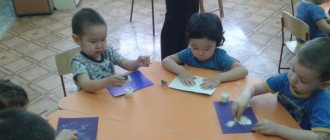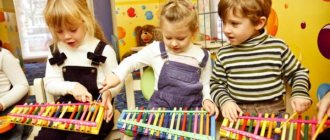In the second and third year of life
Children of the second year of life can actively listen to continuously playing music for 40 seconds, then a break (1-2 seconds) and again for 40 seconds, a pause, etc. In general, one lesson lasts 2-3 minutes.
Children of the third year of life can perceive continuously playing music for 1-1.5 minutes, then a pause and another minute and a half, etc. One lesson - 4-5 minutes.
The numbers - seconds and minutes - are given here so that you do not overestimate the capabilities of a small child and at the same time know that listening to music is quite within the baby’s capabilities. It all depends on his condition at the moment you chose to listen to music: a child listens to music worse if he has just cried - for example, his beloved grandmother has left, or he has just finished feeding him unloved porridge, or maybe he is simply unwell.
When you see that your child is distracted or expresses displeasure, reduce the time of the lesson or move it to another time of the day. If the child’s attention is stable and he is able to perceive music with interest, you can slightly increase the duration of the lesson.
A little about musical instruments
Children's musical instruments: metallophone, xylophone are accompanied by an annotation explaining how and what to play.
Sometimes parents themselves write the names of the notes on the keys: do, re, mi... - this makes it easier for them to select and memorize the proposed music. For songs played on the children's harp, a “string guide” is included. You place a “cheat sheet”—a guide with a drawn arrow—behind the strings and follow its movement, playing the song. The sounds of the harp make children very happy. But the child should listen to music that you have already learned, easily and freely performed. Therefore, teach yourself when the baby does not hear.
It's good if you play the piano, but for a child this is not enough. Do not exclude listening to music played on other musical instruments - harp, pipe, xylophone, tambourine.
Do all children have an ear for music?
Almost all young children are very sensitive to music. This is expressed in a directed interest in musical sounds. Babies begin to smile, move rhythmically, shake their heads, clap their hands, stomp, and sway their bodies in place when they hear nursery rhymes or non-aggressive music.
The sooner a child hears good musical samples, the faster his ear for music develops. If a mother sings lullabies to her child from early childhood, the baby will begin his first attempts at intonation - singing along with his mother - earlier. What will help the rapid development of speech in the future .
Of course, children are given musical talents to varying degrees. However, with the help of music classes, based on the interest that children have in music, it is possible to select such sets of exercises that will help develop existing abilities and instill a love for musical activity in every child.
A little about the tools
Tambourine
It is best to use a small tambourine, with a wooden hoop, not a metal or plastic hoop, with leather stretched over it. If the sound is loud and sharp, remove (remove) a couple of metal plates from the hoop.
So, even at 6 months. kids happily listen to their mother's cheerful singing, accompanied by the rhythmic tapping of a tambourine or the ringing of bells, bells, and a triangle.
You delight your baby with the sound of different instruments, different timbres and at the same time enrich the child’s auditory experience.
The metallophone, harp, and pipe that you played should not be given to the child. Rattles and a small tambourine can be freely used by a child 2-3 years old.
with bells and bells only in the presence of adults - to avoid injury.
What to tell parents
Most parents have no doubt that music lessons are an excellent way to develop a child. However, mothers and fathers do not always know how, when and what exactly their baby can do if he is not yet three years old.
Clients who bring their children to a children's club often want to receive professional explanations about why music classes or musical exercises are needed as part of early development classes.
Unfortunately, administrators are not always able to give detailed answers - they simply do not have knowledge about this area of child development.
I offer you an article in which I answer the most frequently asked questions in an accessible and concise manner and provide facts that will help you convince parents to start music lessons with their children as early as possible.
Give this text to the administrator to read, and he will be able to speak more competently with parents.
This information will also help the teacher - when there is a ready-made structured argument, it is always easier to communicate.
The most frequently asked questions concern:
- optimal age to start such activities
- types of musical activities
- ways to develop a sense of rhythm, musical sensitivity and responsiveness in children.
How to listen to music?
An indispensable condition is silence in the room. Nothing should distract the baby. The mother is sitting next to the child, or the baby is in her arms, or both are sitting on the sofa. Mom listens too. Her face is interested, attentive, friendly. Mom likes music - the child sees this. Her mood and condition are transmitted to the baby. If the mother plays the piano herself, then the grandmother or father sits with the baby.
We recommend listening to music once or twice a day. This could be one piece repeated twice, or two pieces. For example, “Bunny” and “Bear”. By the end of the third year, you can audition three plays.
Have you already noticed that you were offered to play different musical instruments even for a six-month-old baby? But what if you don't have these skills?







